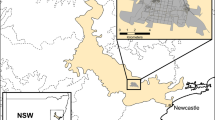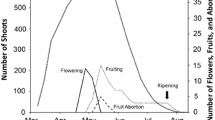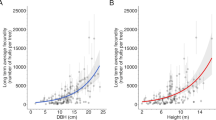Abstract
Will increased fruit and seed production in a severely pollination-limited orchid stimulate population growth? We tested whether safe sites for germination and seedling establishment are limiting for the twig epiphyte, Tolumnia variegata, by manipulating fruit set and monitoring subsequent seedling establishment for two seasons (1991–1992, 1992–1993). In the Cambalache Forest Reserve of Puerto Rico, we established 36 plots along a transect. Each plot consisted of nine trees. A center tree was designated as the site for attaching Tolumnia and manipulating fruit set. The other eight potential host trees were 1–3 and 3–5 m from the center tree in each of the cardinal directions. A 1-m length of stem 1 m from the ground was monitored for recruits on each of the nine trees of 24 fruit-enhanced plots and 12 controls (23 and 13, respectively for the 1992–1993 season). Fruit enhancement plots were divided among two treatments: one-fruit and five-fruit additions for the 1st year and one to five and more than five fruits for the 2nd year. Availability of suitable host species was not limiting. T. variegata showed little specificity for host tree species, good host trees and shrubs were common, and there was no evidence that the orchid had a preference for small branches, despite possessing the entire suite of characteristics thought to respresent “obligate” twig epiphytes. Fruit enhancement increased seed rain and seedling establishment consistently in only the high-fruit treatment plots. Most recruitment occurred near fruiting plants. Over the 2-year period, mortality was 18% for adults and 85.5% for the 1991–1992 cohort of recruits. Net recruitment was positive for both the treatment (average = 1.74) and control plots (average = 0.67). Seedling establishment at our study site was not microsite-limited. If selection for increased pollinator attraction occurs, then an increase in seed output should result in population growth.
Similar content being viewed by others
References
Ackerman JD (1986a) Mechanisms and evolution of food-deceptive pollination systems in orchids Lindleyana 1:108–113
Ackerman JD (1986b) Coping with the epiphytic existence: pollination strategies. Selbyana 9:52–60
Ackerman JD, Galarza-Pérez M (1991) Patterns and maintenance of extraordinary variation in the Caribbean orchid, Tolumnia (Oncidium) variegata. Syst Bot 16:182–194
Ackerman JD, Montalvo AM (1990) Short- and long-term limitations to fruit production in a tropical orchid. Ecology 71: 263–272
Ackerman JD, Montero Oliver JC (1985) Reproductive biology of Oncidium variegatum: moon phases, pollination and fruit set. Am Orchid Soc Bull 54:326–329
Ackerman JD, Zimmerman JK (1994) Bottlenecks in the life histories of orchids: resources, pollination, population structure, and seedling establishment. In: Pridgeon A (ed) Proceedings of the 14th world orchid conference. HMSO, London, pp 125–129
Augspurger CK (1984) Seedling survival of tropical tree species: interactions of dispersal distance, light-gaps, and pathogens. Ecology 65:1705–1712
Bartareau T (1994) The reproductive ecology of Dendrobium toressae (Bailey) Dockr., a geographically restricted species in north-east Queensland. Orchadian 11:106–112
Bierzychudek P (1981) Pollinator limitation of plant reproductive effort. Am Nat 117:838–840
Burd M (1994) Bateman's principle and plant reproduction: the role of pollen limitation in fruit and seed set. Bot Rev 60: 83–139
Calvo RN (1993) Evolutionary demography of orchids: intensity and frequency of pollination and the cost of fruiting. Ecology 74:1033–1042
Calvo RN, Horvitz C (1990) Pollinator limitation, cost of reproduction, and fitness in plants: a transition-matrix demographic approach. Am Nat 136:499–516
Campbell DR (1985) Pollinator sharing and seed set of Stellaria pubera: competition for pollination. Ecology 66:544–553
Campbell DR (1991) Effects of floral traits on sequential components of fitness in Ipomopsis aggregata. Am Nat 137:713–737
Campbell DR, Halama KL (1993) Resource and pollen limitations to lifetime seed production in a natural population. Ecology 74:1043–1051
Chase MW (1987) Obligate twig epiphytism in the Oncidiinae and other neotropical orchids. Selbyana 10:24–30
Clements MA (1987) Orchid-fungus-host associations of epiphytic orchids. In Saito K, Tanaka R (eds) Proceedings of the 12th world orchid conference. 12th World Orchid Conference, Inc., Tokyo, pp 80–83
Crawley MJ (1990) The population dynamics of plants. Phil Trans R Soc Lond B 330:125–140
Darwin C (1885) The various contrivances by which orchids are fertilised by insects, 2nd edn., John Murray, London
Eriksson O, Ehrlén J (1992) Seed and microsite limitation of recruitment in plant population. Oecologia 91:360–364
Fowler NL (1986) Density-dependent population regulation in a Texas grassland. Ecology 67:545–554
Frei JK (1973) Orchid ecology in a cloud forest in the mountains of Oaxaca, Mexico. Am Orchid Soc Bull 42:307–314
Gross KL (1980) Colonization by Verbascum thapsus (Mullein) of an old field in Michigan: experiments on the effects of vegetation. J Ecol 68:919–927
Haig D, Westoby M (1988) On limits to seed production. Am Nat 113:757–759
Hawthorne WR, Cavers PB (1976) Population dynamics of the perennial herbs Plantago major L. and P. rugelii Decne J Ecol 64:511–527
Holdridge LR (1984) Puerto Rican forest land associations. In: Lugo A (ed) Los bosques de Puerto Rico. Servicio Forestal de los Estados Unidos y Departamento de Recursos Naturales, Centro para Estudios Energeticos, University of Puerto Rico, Rio Piedras, pp 35–41
Janzen H, DeVries P, Gladstone DE, Higgins ML, Lewinsohn TM (1980) Self- and cross-pollination of Encyclia cordigera (Orchidaceae) in Santa Rosa National Park, Costa Rica. Biotropica 12:72–74
Johansson DR (1974) Ecology of vascular epiphytes in West African rain forest. Acta Phytogeogr Suec 59:1–129
Little Jr EL, Wadsworth FH (1964) Common trees of Puerto Rico and Virgin Islands. US Department of Agriculture Forest Service, Washington DC
Louda SM (1982) Limitation of the recruitment of the shrub Haplopappus squarrosus (Asteraceae) by flower- and seed-feeding insects. J Ecol 70:43–53
Louda SM (1983) Seed predation and seedling mortality in the recruitment of a shrub, Haplopappus venetus (Asteraceae), along a climatic gradient. Ecology 64:511–521
Meléndez EJ, Ackerman JD (1993) The effects of a rust infection of fitness components in a natural population of Tolumnia variegata (Orchidaceae). Oecologia 94:361–367
Migenis LE, Ackerman JD (1993) Orchid-phorophyte relationships in a forest watershed in Puerto Rico. J Trop Ecol 9:231–240
Molau U, Eriksen B, Knudsen JT (1989) Predispersal seed predation in Bartsia alpina. Oecologia 81:181–185
Montalvo AM, Ackerman JD (1986) Relative pollinator effectiveness and evolution of floral traits in Spathiphyllum friedrichsthalii (Araceae). Am J Bot 73:1665–1676
Montalvo AM, Ackerman JD (1987) Limitations to natural fruit production in Ionopsis utricularioides (Orchidaceae). Biotropica 19:24–31
Nilsson LA (1992) Orchid pollination biology. Trends Ecol Evol 7:255–259
Primack RB, Hall P (1990) Costs of reproduction in the pink lady's slipper orchid: a four year experimental study. Am Nat 136:638–656
Primack RB, Kang H (1989) Measuring fitness and natural selection in wild plant populations. Annu Rev Ecol Syst 20:367–398
Putwain PD, Machin D, Harper JL (1968) Studies in the dynamics of plant populations. II. Components and relation of a natural population of Rumex acetosella L. J Ecol 56:421–431
Rohlf FJ, Sokal RR (1981) Statistical tables, 2nd edn. W. H. Freeman and Company, San Francisco
Schemske DW (1980) Evolution of floral display in the orchid Brassavola nodosa. Evolution 34:489–493
Shaw RG, Antonovics J (1986) Density dependence in Salvia lyrata, a herbaceous perennial: the effects of experimental alteration of seed densities. J Ecol 74:797–813
Snow AA (1982) Pollination intensity and potential seed set in Passiflora vitifolia. Oecologia 55:231–237
Snow AA, Whigham DF (1989) Costs of flower and fruit production in Tipularia discolor (Orchidaceae). Ecology 70:1286–1293
Stephenson AG (1981) Flower and fruit abortion: proximate causes and ultimate functions. Annu Rev Ecol Syst 12:253–279
Wallace B (1968) Topics in population genetics. WW Norton, New York
Willson MF, Burley N (1983) Mate choice in plants: tactics, mechanisms, and consequences. Princeton University Press, Princeton, New Jersey
Zimmerman M (1980) Reproduction in Polemonium: pre-dispersal seed predation. Ecology 61:502–506
Zimmerman JK, Aide TM (1989) Patterns of fruit production in a neotropical orchid: pollinator vs. resource limitation. Am Bot 76:67–73
Zimmerman JK, Olmsted IC (1992) Host tree utilization by vascular epiphytes in a seasonally inundated forest (Tintal) in Mexico. Biotropica 24:402–407
Author information
Authors and Affiliations
Rights and permissions
About this article
Cite this article
Ackerman, J.D., Sabat, A. & Zimmerman, J.K. Seedling establishment in an epiphytic orchid: an experimental study of seed limitation. Oecologia 106, 192–198 (1996). https://doi.org/10.1007/BF00328598
Received:
Accepted:
Issue Date:
DOI: https://doi.org/10.1007/BF00328598




